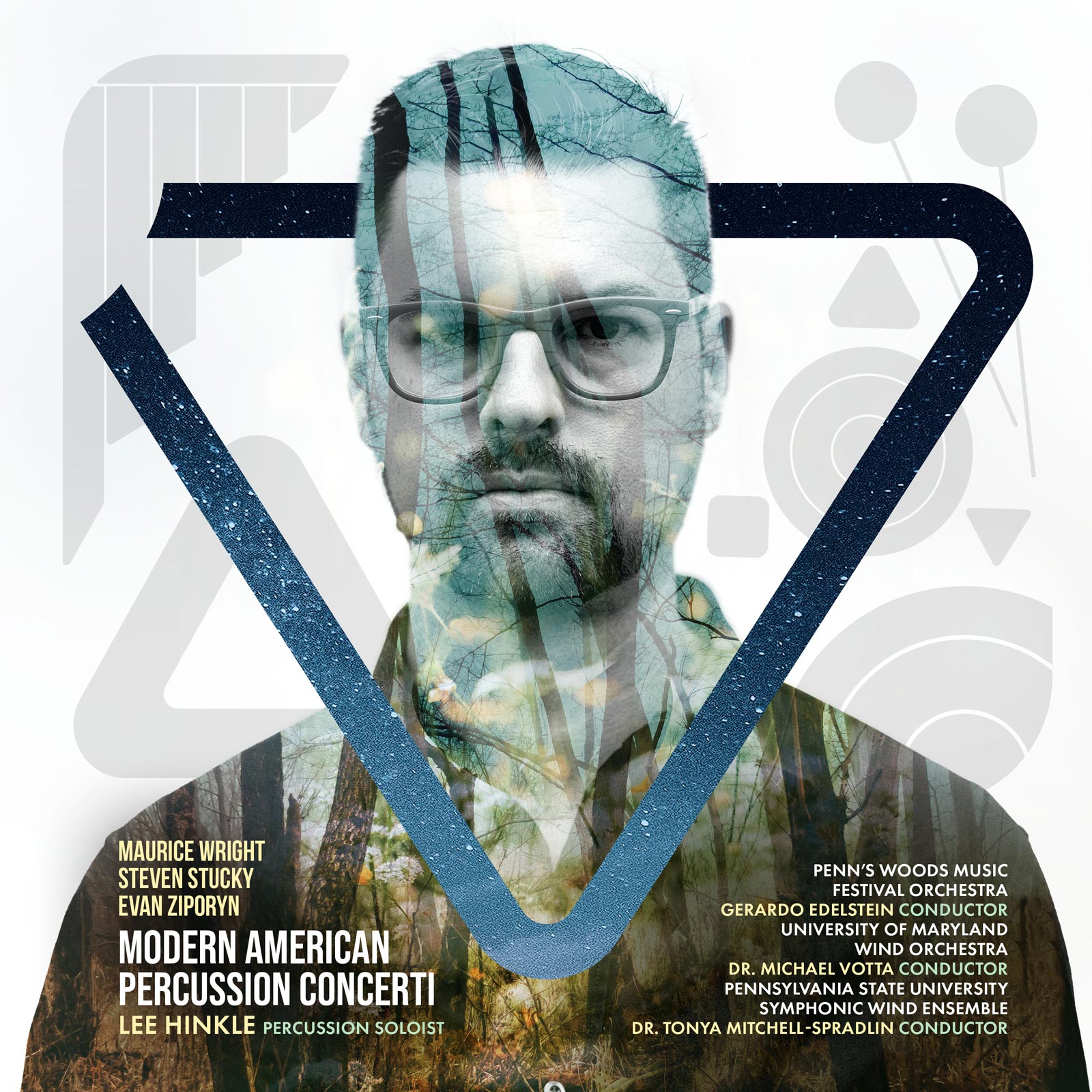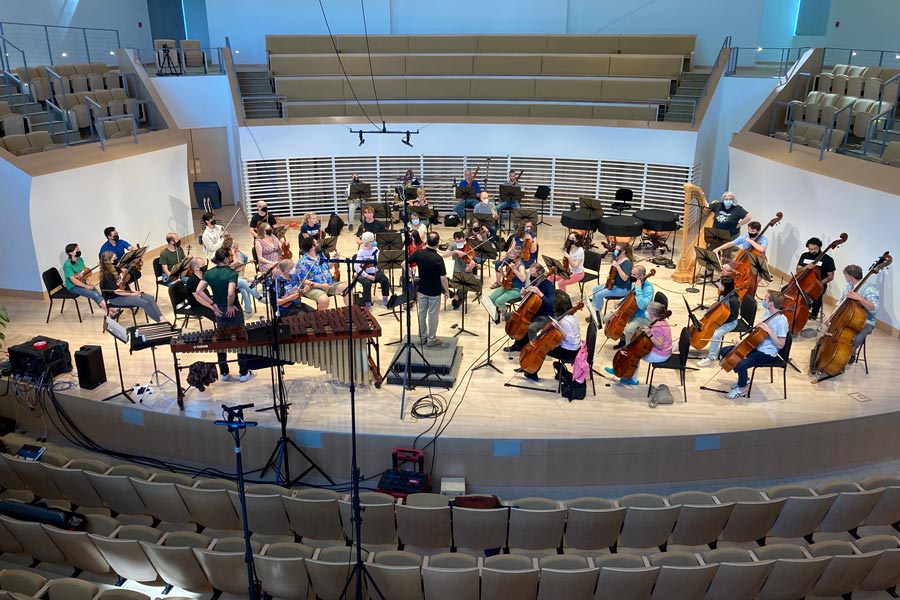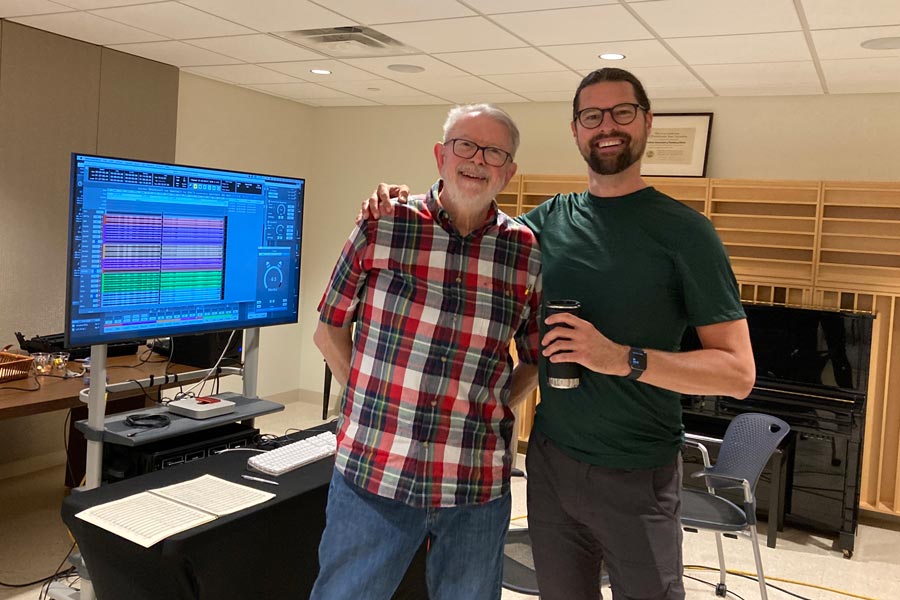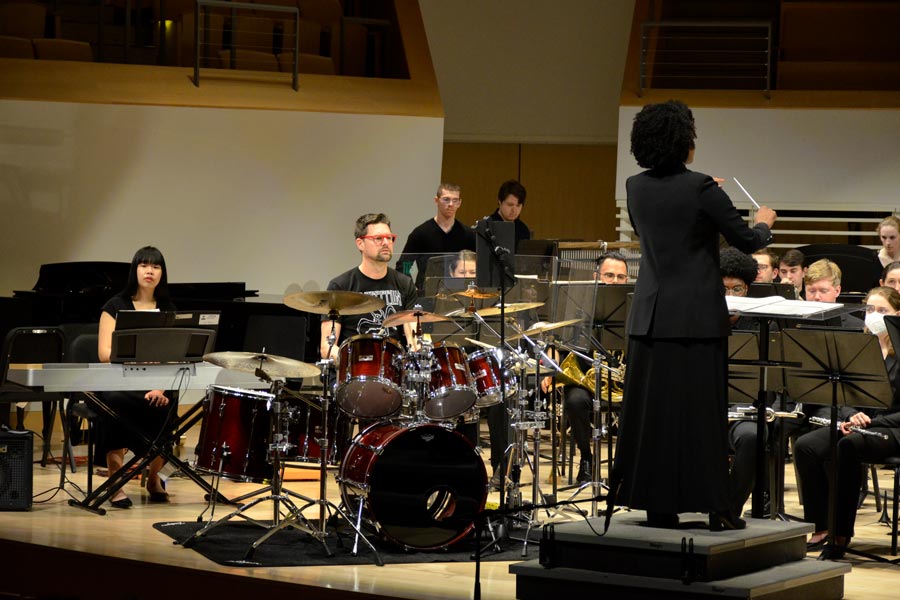Modern American Percussion Concerti
Maurice Wright composer
Steven Stucky composer
Evan Ziporyn composer
Lee Hinkle percussion
Penn’s Woods Music Festival Orchestra
Gerardo Edelstein conductor
University of Maryland Wind Orchestra
Dr. Michael Votta conductor
Pennsylvania State University Symphonic Wind Ensemble
Dr. Tonya Mitchell-Spradlin conductor
Owing to the collaboration and performance of hundreds of students, faculty, and staff collaborators, the Penn’s Woods Festival Orchestra, the University of Maryland Wind Orchestra, and the Penn State University Wind Ensemble perform alongside Lee Hinkle to acclaim the percussion concerti of three modern American composers. Hinkle meets the evolving modal complexity of Maurice Wright’s Concertpiece for Marimba and Orchestra with the same central drumset vivacity that breathes life into Evan Ziporyn’s Impulse Control, while still saving space for the solemn anthem layered in the rich solo instrumentation of Steven Stucky’s Concerto for Percussion and Wind Orchestra. Whether on marimba, drumset, or any percussive tool between, Hinkle shines solo in the seven-year cumulation of a monumental musical undertaking, coming together as MODERN AMERICAN PERCUSSION CONCERTI.
This project was made possible in part by a Faculty Research Grant from the Penn State College of Arts and Architecture.
Listen
Stream/Buy
Choose your platform
Track Listing & Credits
| # | Title | Composer | Performer | |
|---|---|---|---|---|
| 01 | Concertpiece for Marimba and Orchestra: I. Vivo | Maurice Wright | Lee Hinkle, marimba soloist; Penn’s Woods Festival Orchestra | Gerardo Edestein, conductor | 8:41 |
| 02 | Concertpiece for Marimba and Orchestra: II. Adagio | Maurice Wright | Lee Hinkle, marimba soloist; Penn’s Woods Festival Orchestra | Gerardo Edestein, conductor | 5:02 |
| 03 | Concertpiece for Marimba and Orchestra: III. Brillante | Maurice Wright | Lee Hinkle, marimba soloist; Penn’s Woods Festival Orchestra | Gerardo Edestein, conductor | 11:19 |
| 04 | Concerto for Percussion and Wind Orchestra: I. Energico | Steven Stucky | Lee Hinkle, percussion soloist; University of Maryland Wind Orchestra | Michael Votta, Jr., conductor | 3:21 |
| 05 | Concerto for Percussion and Wind Orchestra: II. Moderato delicato, quasi senza tempo | Steven Stucky | Lee Hinkle, percussion soloist; University of Maryland Wind Orchestra | Michael Votta, Jr., conductor | 5:18 |
| 06 | Concerto for Percussion and Wind Orchestra: III. Vivace | Steven Stucky | Lee Hinkle, percussion soloist; University of Maryland Wind Orchestra | Michael Votta, Jr., conductor | 3:40 |
| 07 | Concerto for Percussion and Wind Orchestra: IV. Grave (To the Victims of September 11, 2001) | Steven Stucky | Lee Hinkle, percussion soloist; University of Maryland Wind Orchestra | Michael Votta, Jr., conductor | 4:16 |
| 08 | Concerto for Percussion and Wind Orchestra: V. Gioioso | Steven Stucky | Lee Hinkle, percussion soloist; University of Maryland Wind Orchestra | Michael Votta, Jr., conductor | 3:22 |
| 09 | Impulse Control (Concerto for Drum Set and Wind Ensemble): I. | Evan Ziporyn | Lee Hinkle, drum set soloist; Penn State University Wind Ensemble | Tonya Mitchell-Spradlin, conductor | 3:57 |
| 10 | Impulse Control (Concerto for Drum Set and Wind Ensemble): II. | Evan Ziporyn | Lee Hinkle, drum set soloist; Penn State University Wind Ensemble | Tonya Mitchell-Spradlin, conductor | 15:14 |
This project was made possible by The Percussion Department Endowed Excellence Fund and in part by a Faculty Research Grant from the Penn State College of Arts and Architecture.
Cover Art Photo Chase Gutierrez
Concertpiece for Marimba and Orchestra
Recorded June 2022 at the Recital Hall, Penn State School of Music in State College PA
Recording Session Producer Maurice Wright
Recording Session Engineer, Editing & Mixing Curtis Craig
Concerto for Percussion and Wind Orchestra
Recorded October 2016 at the Dekelboum Concert Hall, Clarice Smith Performing Arts Center, University of Maryland in College Park MD
Recording Session Producer Michael Votta, Jr.
Recording Session Engineer, Editing & Mixing Antonino D’Urzo
Impulse Control
Recorded April 2023 at the Esber Rehearsal Hall, Penn State School of Music in State College PA
Recording Session Producer Tonya Mitchell-Spradlin
Recording Session Engineer, Editing & Mixing Curtis Craig
Impulse Control was funded in part by the MidAmerican Center for Contemporary Music, Kurt Doles, director, and the Bowling Green State University Wind Symphony, Kenneth Thompson, Director, at the College of Musical Arts of BGSU. Additional funding was provided by a consortium of percussionists and university band programs.
Consortium Members:
Roger Braun & Andrew Trachsel, Ohio University
Ian Ding, University of Michigan
Lee Hinkle & Michael Votta, University of Maryland
Ricardo Flores, University of Illinois at Urbana-Champaign
Kenneth Thompson, Bowling Green State University
Mastering Melanie Montgomery
Executive Producer Bob Lord
VP of A&R Brandon MacNeil
A&R Ivana Hauser
VP of Production Jan Košulič
Audio Director Lucas Paquette
VP, Design & Marketing Brett Picknell
Art Director Ryan Harrison
Design Edward A. Fleming, Morgan Hauber
Publicity Aidan Curran
Artist Information
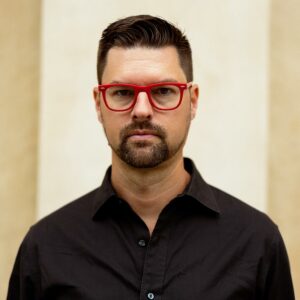
Lee Hinkle
Dr. Lee Hinkle’s percussion playing has been called “rock-steady” by the Washington Post. He is the principal percussionist with the 21st Century Consort and he made his Carnegie Hall solo debut in 2014 as a concerto soloist. Hinkle’s other notable performances have included the National Symphony, Columbus Symphony, and American Institute for Musical Studies Orchestra (Graz, Austria) as well as national U.S. tours with Bebe Neuwirth, Bernadette Peters, and the American Wind Symphony Orchestra. He has performed as a soloist at three Percussive Arts Society International Conventions and is an active commissioner and curator of contemporary music for percussion.
Penn’s Woods Festival Orchestra Members
VIOLINS
James Lyon, concertmaster
Joanne Feldman
John Brauer
Michael Divino
Ian Duh
Michael Fisher
Gregory Glessner
Sarah Hamm
Emily Long
Carissa McQuaid
Mark Minnich
Sally Minnich
Allison Smith
Spenser Stover
May Zia
Rachel Zimmerman
VIOLAS
Melinda Daestch, principal
John Roxburgh
Anna Dye
Taylor Shea
Andrea Alvarado
Liz King
Isabel Healy
CELLOS
Kim Cook, principal
Stephen Feldman
Carol Lyon
Jonathan Dexter
Hudson Webber
Annabelle Lecy
BASSES
Joshua Davis, principal
Justin Dorsey
Alexander McLaughlin
Benjamin Byham
FLUTES
Naomi Seidman, principal
Cathy Herrera
OBOES
Andreas Oeste, principal
Robyn Dixon Costa
BASSOONS
Daryl Durran, principal
Reed Hanna
HORNS
Lisa Bontrager, principal
Sarah Schouten
HARP
Julia Scott
LIBRARIAN
Andrea Alvarado
COMPANY MANAGER
Tomas Garcias Duenas
University of Maryland Wind Orchestra Members
FLUTES
Megan Gryder
Alisa Oh
Grace Wang
OBOES
Amanda Dusold
Angela Kazmierczak
Santiago Vivas-Gonzalez
CLARINETS
Robert Durie
Nathan Dorsey
Gabe Ferreira
Bethany Lueers
Melissa Morales
BASSOONS
Lauren Kantelis
Brian Kennedy
HORNS
Grace Chan
Michael Fries
Amanda Fry
Ben Yehle
Al Rise
Ben Yehle
TRUMPETS
Alexis Kalivretenos
Ben Lostocco
Ross McCool
Isaac Segal
Frank Stroup
TROMBONES
Dan Pendley
Nathan Reynolds
Rich Matties
BASS TROMBONE
Matt Myers
TUBA
Joshua Lewis
Nick Obrigewitch
PIANO
Szu-Yi Li
PERCUSSION
Lauren Floyd
Jessica Kincaid
Anthony Konstant
David Lu
Matt Miller
Penn State University Wind Ensemble Members
FLUTES
Joshua Benitez, Alto
Abigail Wobber
Megan Russell
OBOE
Katelyn Estep
ENGLISH HORN
Abigail Alexander
CLARINETS
Rebecca Reeder
Gregory Glatzer
Chandler Cleric
Michael Dews
BASS CLARINET
Samantha Elliott
BASSOONS
Bradley Sarmiento
Benjamin Hochman
SAXOPHONES
Shannon Donahoe, Soprano
Aaron Kaufman, Alto
Luke Kranyak, Tenor
Lauren Ackerman, Baritone
FRENCH HORNS
Ryan Peterson
Samantha Duhé-Jones
Bryan Manzano
Ashley Godwin
TRUMPETS
Hayden Cameron
Tanner Deyo
David Hutchinson
TROMBONES
Andrew Zall
Michael Thomas
Isaiah Ebersole
Jacob Green
BASS TROMBONES
Erik Barber
EUPHONIUM
Samuel Fisher
William Jones
TUBAS
David Popkin
Jaden Adkins
PERCUSSION
Ross Campanella
Gage Kroljic
Isabella Scotti
Kyle Scully
Caden Werner
Zach Wilson
BASS
Frank Clocke
PIANO
Annie Huang

